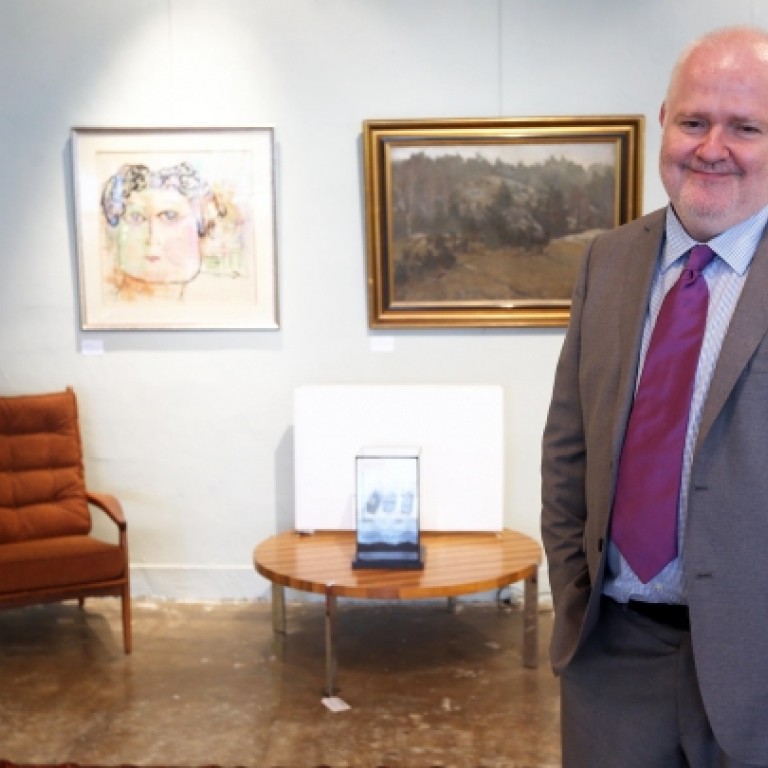
Hong Kong's middle market goes under the hammer
A new auction house is focusing on what founder Steve Freeman sees as a gap in the sales market - mid-priced 'normal stuff'
An 8,000 sq ft space tucked away in an Ap Lei Chau warehouse is Steve Freeman's latest labour of love. An avid art collector and regular fixture on the local art scene, Freeman is the organiser of ArtWalk HK and now the founder of the city's only mid-market auction house, called Gresham's.
Freeman's concept for the auction house came about via a friend who complained about how hard it was to sell stuff through auction in Hong Kong. Surprised to hear this, Freeman tried to put some items up for sale himself, just to see what would happen, and as it turns out "although there are things that are easy to sell in Hong Kong there wasn't a venue for what I'd say 'normal stuff' to be sold. I said to myself, 'Well, heck I can do this. It's not that hard.'"
Most of the items at Gresham's falls in the range of HK$1,000 to HK$100,000, or what's called the middle market. Any higher than that and it gets the interest of Christie's and Sotheby's. Any lower than that and it would appear on GeoExpat.

The name comes from Freeman's English ancestry. "My mother's mother was a Gresham. It's a very old family in the United Kingdom and [Sir Thomas Gresham] was a very interesting man, the founder of Gresham College in London, also the founder of the Royal Exchange," he says, explaining that the building - a London landmark - was used by merchants and tradesmen for trading.
"It was a place to simply buy and sell stuff. It was the first purpose-built building in the UK for trading. I thought, well, that's very appropriate," says Freeman.
Gresham's first auction took place at the beginning of the month with 148 lots up for bidding. The theme was interiors and included items such as a 19th century Chinese lacquered writing slope that sold for HK$10,000, an 18th century copper chocolate pot priced at HK$4,000 and a lounge chair by famed 20th century designer Milo Baughman for about HK$24,000.
Freeman says they accept a wide range of items. If customers are interested in selling, Gresham's needs just three things: a picture, a five-word description and the price they want to sell it for.
"We can do a quick evaluation and if we think we can help them then we'd view the items, probably here [at Gresham's] unless it's very difficult to move," he says.
The auction house would then do a little research, write it up and distribute a catalogue. Should the item sell, Gresham's takes a cut of between 12 and 20 per cent.
Although Gresham's is in a tier of its own now, it's not the first ever mid-market, multi-category auction house in Hong Kong. "Thirty years ago there was an auction house like us but it got priced out. Now it's Abercrombie and Fitch," Freeman says, referring to Lammert Brothers, which was set up in the mid-19th century in the Pedder Building space now occupied by the preppie-clothing retailer.
Freeman is confident that Gresham's won't meet a similar fate, saying Lammert's faced high Central rents and an auction market that wasn't fully developed. "The art and auction market in the last five years has seen explosive growth," Freeman says. "Now there's a dozen or more major international galleries in addition to a hundred or so local galleries.
He notes that the major Chinese auction houses have come to Hong Kong, as has Art Basel, and says the city is now one of the three major art markets. "It's now New York, London, and Hong Kong. There's no question about it. Five years ago, you wouldn't have put Hong Kong in that list," says Freeman.
The biggest draw though may be for buyers who enjoy a bit of serendipity. Auction house players like China Poly and Sotheby's sell things at a price range much too high for most buyers to purchase on a whim. Meanwhile an antique store will usually be quite specialised and its inventory is slow to turn over, removing much of the element of surprise.
"The difference between an auction house and an antique store is that the inventory changes 100 per cent every week," Freeman says. "[At an antique store] you can see very beautiful things and come back in a year and see many of the same beautiful things. The point of the auction house is, if it's successful, the turnover is rapid and every day is a surprise. You don't walk in knowing what you're going to buy. You find out."
